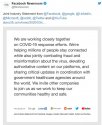A foreseeable catastrophe: how Covid-19 swept through Victoria’s nursing homes
 A foreseeable catastrophe: how Covid-19 swept through Victoria’s nursing homes
A foreseeable catastrophe: how Covid-19 swept through Victoria’s nursing homes
Melissa Davey and Gay Alcorn
4 hrs ago
What’s caused this?
Returned international travellers to Australia are sent straight to hotels and mandated to quarantine for 14 days, and offered COVID-19 testing. In June, it was revealed by the premier Daniel Andrews that security staff monitoring those returned travellers had breached “well-known and well-understood infection control protocols”. They acquired the virus from travellers and then spread it through the community, where it subsequently spread to aged care.
The federal health minister Greg Hunt has said the outbreak of the virus from the hotel quarantine program has led to “catastrophic human outcomes”, including the spread into aged care. Hunt said aged care residents represented about 70% of the cases diagnosed in Victoria since 1 July. There has been “major community transmission as a consequence” of that initial hotel breach, Hunt said.
Is it that simple?
No. An insecure, casual workforce has allowed the virus to spread. Aged care workers often work across multiple facilities to make ends meet, and sometimes work while sick due to
poor sick leave entitlements and longstanding staffing pressures.
Workers acquired the virus in one facility, then spread it when they went to their next shift at another facility. Some worked with symptoms or while awaiting test results because they could not afford to take leave. Others had no symptoms, spreading the virus unknowingly. Delays between the time of testing and getting results exacerbated this issue.
Labor’s aged care spokesperson, Julie Collins, said there were also reports providers did not have adequate personal protective equipment, and there have also been reports about haphazard training protocols on how to use that equipment
.
The issues in aged care generally were known well before the pandemic. An interim report from Australia’s royal commission into aged care, published in October, was scathing about the sector. “Left out of sight and out of mind, these important services are floundering,” the report said. “They are fragmented, unsupported and underfunded. With some admirable exceptions, they are poorly managed. All too often, they are unsafe and seemingly uncaring. This must change.”
What is being done about the crisis?
On 23 July the Victorian government announced a $300 COVID-19 “test isolation payment” to support Victorian workers, including parents and guardians, who are required to self-isolate while waiting for test results if they have no sick leave entitlements.
Related:
Victorian health worker mistakenly told she tested positive for COVID-19, throwing surgical clinic into disarray
On 28 July,
the premier announced all non-urgent elective surgery in Victoria would be halted and specialist health staff from those clinics would take over care in aged care facilities. Andrews said he did not have confidence that existing aged care staff could keep residents safe amid the outbreaks.
Australian Medical Assistance Teams are being sent into Victoria to help in aged care, and five million masks from the national medical stockpile are being directed to the state’s sector, as well as 500,000 face shields.
Workers
in residential aged care will also receive two weeks paid pandemic leave whenever they need to isolate, until mid-October. But Aged and Community Services Australia, the Aged Care Guild and Leading Age Services Australia released a joint statement to say they are concerned the government funding to cover pandemic leave only applies for eight weeks, and the sector can’t afford to pick up the rest of the cost.




